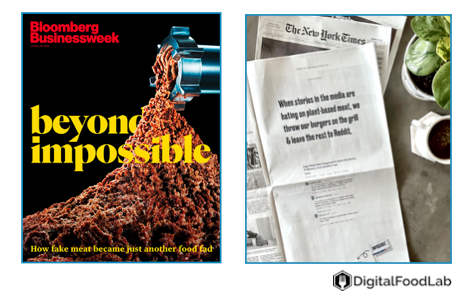Putting innovations on the market is really hard. You must fight multiple battles simultaneously, from consumer adoption to funding your growth. This often leads entrepreneurs to overpromise and hence to disillusions. I feel that plant-based meat is just at this stage right now (if not the entire alternative protein ecosystem). Let’s take a long view to understand where we are.
Last week, Bloomberg released an article called “fake meat was supposed to save the world. It became just another fad”. It caused a lot of fuss in the FoodTech microcosm, as it is a shameless attack on Beyond Meat and Impossible Foods, the two “historical” leaders. The magazine cover goes as far as comparing them to 💩 (see below). This created a pile of articles in defence of these two companies or of the overall plant-based meat category. Impossible Foods paid for a whole page in the New York Times (see below), saying that it had supporters on Reddit (a weird choice I think).

So, beyond the noise, what should we think about that? The article was globally right when saying that:
- Most plant-based meat products don’t taste good. Startups are overpricing on taste and texture, often telling consumers that their product taste as good as meat, which is often a blatant lie, which in turn can lead to a level of mistrust on other allegations.
- The link between plant-based meat and healthiness is fading (due to high processing). As it was the main reason for consumers to buy meat alternatives, it can help to explain the stagnation in sales observed in some markets.
It was a bit catchy and exaggerated by focusing only on a couple of startups (but it was an article, not a report), by generalising the US situation, and most of all by discounting all the other meat alternatives as irrelevant. In a word, consumers want products that taste good (which means as good as meat here) and are at least as affordable. And, on both marks, we are far from it by a long shot.
However, it does not mean that things are over and that plant-based meat was a fad. That’s where long-term disruptive innovation gets a bit more complicated (or interesting). We like to use the hype curve below to see how things move forward. However, it is only a tool, and mistakes are still possible. I think that most people thought that plant-based meat products were actually market ready that It was only a matter of time before they would reach the mass market. But we were collectively wrong. We were just in the excitement phase, with a lot of hype and not that much reality check.

Plant-based meat is “just” going through a normal disillusionment phase. It’s nothing unusual for a new technology/trend. As it was not yet ready for mass adoption and needs multiple improvements (texture, price, taste, capabilities), the hype is fading, and we hear doomsayers telling the tale of its end.
In a word, things are bad for plant-based meat, but that’s ok. Beyond Meat and Impossible Foods are actually entering their adolescent years as the overall ecosystem. Things will be bumpy for the next 2 to 4 years, but much of the future truly looks promising for alternative proteins. Indeed:
- The reasoning behind alternatives to animal proteins is stronger than ever. Animal farming emits a large and growing amount of greenhouse gases. Additionally, the number of consumers looking for animal products is growing fast globally.
- Answers to the main challenges facing these alternatives are being developed, from better-tasting products, new textures, and additional capabilities being built to reduce prices.
- New technologies such as precision fermentation and cellular agriculture are due to create additional offerings (notably by producing and blending them with plants).
If you want to know more about the future of proteins, notably opportunities and challenges, we have worked on an insight report on this subject with MSCI, a leading financial company editing a food revolution index. You can download it (for free) here!







